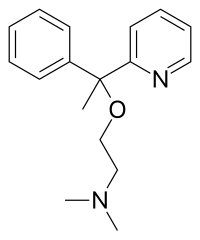Doxylamine
 | |
 | |
| Clinical data | |
|---|---|
| Trade names | Unisom, Vicks Formula 44 (in combination with Dextromethorphan), others |
| AHFS/Drugs.com | Monograph |
| MedlinePlus | a682537 |
| Pregnancy category |
|
| Routes of administration | By mouth |
| ATC code | |
| Legal status | |
| Legal status | |
Intranasal: 70.8%[1] | |
| Metabolism | Hepatic (CYP2D6, CYP1A2, CYP2C9)[2] |
| Elimination half-life | 10–12 hours (range 7–15 hours)[2][3][4] |
| Excretion | Urine (60%), feces (40%)[5] |
| Identifiers | |
| |
JSmol) | |
| |
| |
| (verify) | |
Doxylamine, sold under the brand name Unisom among others, is an
.Doxylamine was first described in 1948 or 1949.[7] Several of the first-generation antihistamines, including doxylamine, are the most widely used sleep medications in the world.[8] Doxylamine is also a potent anticholinergic, which means it also works as a deliriant at much higher than recommended doses as a result.[9] Its sedative and deliriant effects have led to some cases of recreational use.
Medical uses
Doxylamine is an antihistamine used to treat
Insomnia
The first-generation sedating antihistamines
A major
Doses of doxylamine that have been used for sleep range from 5 to 50 mg, with 25 mg being the typical dose.[15][16][17][18]
Morning sickness
Doxylamine is used in the combination drug pyridoxine/doxylamine to treat morning sickness (nausea and vomiting of pregnancy).[19][20][21] It is the only medication approved by the United States Food and Drug Administration for the treatment of morning sickness.[19][20]
Available forms
Doxylamine is used medically as doxylamine succinate, the
Contraindications
The
Side effects
Because of its relatively long
Antihistamines like doxylamine are sedating initially but
Occasional case reports of coma and rhabdomyolysis have been reported with doxylamine.[2] This is in contrast to diphenhydramine.[2]
Studies of doxylamine's
Continuous and/or cumulative use of anticholinergic medications, including first-generation antihistamines, is associated with a higher risk of cognitive decline and dementia in older people.[31][32]
Overdose
Doxylamine is generally safe for administration to healthy adults. Doses of doxylamine of up to 1,600 mg/day for 6 months have been given to adults with
Pharmacology
Pharmacodynamics
| Site | Ki (nM) | Species | Ref |
|---|---|---|---|
| SERT | >10,000 | Human | [38] |
| NET | >10,000 | Human | [38] |
| DAT | >10,000 | Human | [38] |
| 5-HT2A | >10,000 | Human | [38] |
| 5-HT2C | >10,000 | Human | [38] |
| α1B | >10,000 | Human | [38] |
| α2A | >10,000 | Human | [38] |
| α2B | >10,000 | Human | [38] |
| α2C | >10,000 | Human | [38] |
| H1 | 42 | Human | [38] |
| H2 | ND | ND | ND |
| H3 | >10,000 | Human | [38] |
| H4 | ND | ND | ND |
| M1 | 490 | Human | [38] |
| M2 | 2,100 | Human | [38] |
| M3 | 650 | Human | [38] |
| M4 | 380 | Human | [38] |
| M5 | 180 | Human | [38] |
| Values are Ki (nM), unless otherwise noted. The smaller the value, the more strongly the drug binds to the site. | |||
Doxylamine acts primarily as an
Pharmacokinetics
The

Chemistry
Doxylamine is a member of the
History
Doxylamine is a first-generation antihistamine and was discovered by Nathan Sperber and colleagues and was first reported in 1948 or 1949.[43][7][44] It has been the antihistamine component of NyQuil since 1966.[43]
Bendectin, a combination of doxylamine, pyridoxine (vitamin B6), and
Society and culture
Formulations
Doxylamine is primarily used as the succinic acid salt, doxylamine succinate.
- It is the sedating ingredient of acetaminophen).
- In Commonwealth countries, such as Australia, Canada, South Africa, and the United Kingdom, doxylamine is available prepared with paracetamol (acetaminophen) and codeine under the brand name Dolased, Propain Plus, Syndol, or Mersyndol, as treatment for tension headache and other types of pain.
- Doxylamine succinate is used in general over-the-counter sleep-aids branded as Somnil (South Africa), Dozile, Donormyl, Lidène (France, Russian Federation), Dormidina (Spain, Portugal), Restavit, Unisom-2, Sominar (Thailand), Sleep Aid (generic, Australia) and Dorminox (Poland).
- In the United States:
- Doxylamine succinate is the active ingredient in many over-the-counter sleep-aids branded under various names.
- Doxylamine succinate and pyridoxine (Vitamin B6) are the ingredients of Diclegis, approved by the FDA in April 2013 becoming the only drug approved for morning sickness[46] with a class A safety rating for pregnancy (no evidence of risk).
- In Canada:
- Doxylamine succinate and pyridoxine (vitamin B6) are the ingredients of Diclectin, which is used to prevent morning sickness.
- It is also available in combination with vitamin B6 and folic acidunder the brand name Evanorm (marketed by Ion Healthcare).
- In India
- Doxylamine preparations are available typically in combination with pyridoxine that may also contain folic acid. Doxylamine usage is thus restricted for pregnant women.
References
- ^ S2CID 32126626.
- ^ ISBN 978-1-4377-2773-9.
- ^ PMID 29671128.
- ^ PMID 27057416.
- ^ a b c "New Zealand Datasheet: Doxylamine Succinate" (PDF). Medsafe, New Zealand Medicines and Medical Devices Safety Authority. 16 July 2008. Archived from the original on 22 March 2016.
- ^ PMID 17824496.
- ^ ISBN 9783527607495.
- ^ PMID 22035879.
- ^ "Doxylamine - PsychonautWiki".
- ^ "Doxylamine: MedlinePlus Drug Information".
- PMID 15226287.
- ^ PMID 18853708.
- ^ PMID 27998379.
- ^ S2CID 250536370.
- ISBN 9780781762731.
- S2CID 151085176.
- PMID 26609210.
- ^ S2CID 210086511.
- ^ PMID 24748822.
- ^ PMID 24574047.
- PMID 24421551.
- ^ a b c d e "Drugs@FDA: FDA-Approved Drugs". accessdata.fda.gov. Retrieved 23 August 2022.
- ^ "VICKS NYQUIL COLD AND FLU - acetaminophen, dextromethorphan hydrobromide, and doxylamine succinate capsule, liquid filled". DailyMed. U.S. National Library of Medicine.
- ^ "Nyquil Cold and Flu: Basics, Side Effects & Reviews".
- PMC 4989726.
- ISBN 978-0-323-47349-1.
- ISBN 978-0-7295-8345-9.
- S2CID 6849261.
- ^ Doxylamine succinate (CAS 562-10-7) Archived 1 May 2012 at the Wayback Machine. berkeley.edu.
- ^ DOXYLAMINE SUCCINATE. International Agency for Research on Cancer (IARC) – Summaries & Evaluations.
- PMID 25621434.
- PMID 19636034.
- OCLC 1768512.
- ^ "DOXYLAMINE SUCCINATE". hazard.com. Archived from the original on 17 January 2022.
{{cite web}}: CS1 maint: unfit URL (link) - PMID 21686586.
- PMID 11465247.
- ^ Roth BL, Driscol J. "PDSP Ki Database". Psychoactive Drug Screening Program (PDSP). University of North Carolina at Chapel Hill and the United States National Institute of Mental Health. Retrieved 14 August 2017.
- ^ PMID 23357028.
- ^ PMID 23229983.
- PMID 19153052.
- S2CID 6020605.
- PMID 23173575.
- ^ OCLC 1048922805.
- PMID 18113525.
- ^ OCLC 1232803849.
- PMID 24645939.
